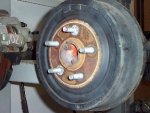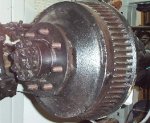On the "average" 1/2 ton axle the weight of the vehicle actually sits directly on the axle itself therefor putting stress on the axleshaft. It's right at the end of the axle on the bearing. A full floating axle the axle itself has no weight of the vehicle on it. The axle tube holds the weight instead.
"A semi-floating axle is very common on the rear of most 4x4s. It consists of an axleshaft on each side that is splined on the inner end where it mates to the differential and has a wheel ****** where the wheel studs mount at the other end. This assembly typically mates to the end of the axlehousing using some type of ****** arrangement. The axleshaft also rides on a large roller or ball bearing out at the end of the axlehousing.
The axleshaft in a semi-floating assembly serves two purposes. First, it attaches to the wheel and is used to support the weight of the vehicle and its cargo. Second, the axleshaft must transmit the rotational torque from the differential out to the wheel.
A full-floating axle can be found on the rear of some 4x4s, but it is generally reserved for vehicles that are designed for severe duty, or are intended to carry heavy loads. This type of axle uses an axleshaft on each side that is simply splined at both ends or splined on the inner end and has a drive ****** on the outer end. The shaft mates to the differential in the same way as a semi-floater. However, the outer end of the shaft differs. Here, the splined end of the shaft slides into a locking hub or an internal splined steel drive plate that bolts to a hub cap, similar to what is found on a front axle. In some cases, the drive ****** may be part of the shaft itself. In either case, the axleshaft is allowed to float in the system.
For a full-floater system, the axleshaft only serves to transmit the rotational torque from the differential out to the wheel. It does not carry the weight of the vehicle like a semi-floater does. On a full floater, a spindle is attached to the outer end of the axlehousing. The hub's cap is attached to this spindle and rides on tapered roller bearings. It is this assembly that carries the vehicle weight. As such, a full-floating axle system is considerably stronger than an equivalently sized semi-floating system."
This is from
http://www.off-roadweb.com/tech/0112or_sem...xles/index.html
If you need more information just copy and past the above URL in your URL bar. Pretty good information.
As for pulling the gearset out it's not to dificult, most axles have a "C" clip that hold them in so you have to pull off the cover and pull those out so you can pull out the axles. Then there are four bolts (two on either side) and it'll come out with a little spinning to get the gears off of the pinion gear. Now the pinion is a little different. You'll want to take the bolt off of it before doing anything else so you can use the tires to help hold it. This usually takes a helping hand or two since I believe the bolt is on somewhere around 200ftlbs or so i think. Also remember, in doing gears you have to go word for word in the instructions or your lovely new gears wont last for long. They're a bit difficult to do from my understanding since you have to have shims for the pinion and ring. Hope this helps and doesn't discurage you to doing it. Another thing to note is every axle has a different size gear that can be put in it like the biggest for an 8.8 is 4.88's I think and if you want to go lower you have to get a different axle to hold the larger ring gear and also so you don't end up with a super small pinion gear.
EDIT: If you do this at the Junkyard dont forget your 1/2" sockets and your breaker bar!


